General Ordinances - City of New Buffalo
General Ordinances - City of New Buffalo
General Ordinances - City of New Buffalo
You also want an ePaper? Increase the reach of your titles
YUMPU automatically turns print PDFs into web optimized ePapers that Google loves.
CITY OF NEW BUFFALO<br />
CODE OF ORDINANCES<br />
Section 16-10. Private sewage disposal.<br />
A. Where a public sanitary or combined sewer is not available under the provisions <strong>of</strong> Section 16-9, the building<br />
sewer shall be connected to a private sewage disposal system complying with the regulations <strong>of</strong> the <strong>City</strong> and <strong>of</strong><br />
the Berrien County Health Department.<br />
B. As such time as a public sewer becomes available to a property served by a private sewage disposal system, as<br />
provided in Section 16-9, a direct connection shall be made to the public sewer in compliance with this Chapter,<br />
and any septic tanks, cesspools, and similar private sewage disposal facilities shall be abandoned and filled with<br />
suitable material.<br />
C. The owner shall operate and maintain the private sewage disposal facilities in a sanitary manner at all times, at<br />
no expense to the <strong>City</strong>.<br />
D. No statement contained in this Chapter shall be construed to interfere with any additional requirements that may<br />
be imposed by the <strong>City</strong> or the Berrien County Health Department.<br />
Section 16-11. Building sewers and connections.<br />
A. No unauthorized and unlicensed person shall uncover, make any connections with or opening into, use, alter, or<br />
disturb any public sewer or appurtenance there<strong>of</strong> without first obtaining a written permit from the District.<br />
B. There shall be two (2) classes <strong>of</strong> building sewer permits: (1) For residential and commercial service, and (2)<br />
For service to establishments producing industrial wastes. In either case the owner or their agent shall make<br />
application on a special form furnished by the <strong>City</strong>. The permit application will be supplemented by any plans,<br />
specifications, or other information considered pertinent in the judgment <strong>of</strong> the Superintendent. A permit and<br />
inspection fee for an industrial building sewer permit shall be paid to the <strong>City</strong> Treasurer at the time the<br />
application is filed.<br />
C. All costs and expense incident to the installation and connection <strong>of</strong> the building sewer shall be borne by the<br />
owner. The owner shall indemnify the <strong>City</strong> from any loss or damage that may directly or indirectly be<br />
occasioned by the installation <strong>of</strong> the building sewer.<br />
D. A separate and independent building sewer shall be provided for every building; except where a building stands<br />
at the rear <strong>of</strong> another on an interior lot and no private sewer is available or can be constructed to the rear<br />
building through an adjoining alley, court, yard, or driveway, the building sewer from the front building may be<br />
extended to the rear building and the whole considered as one (1) building sewer.<br />
E. Old building sewers may be used in connection with new buildings only when they are found, upon<br />
examination and test by the Superintendent, to meet all requirements <strong>of</strong> this Chapter.<br />
F. The size, slope, alignment, materials <strong>of</strong> construction <strong>of</strong> a building sewer, and the methods to be used in<br />
excavation, placing <strong>of</strong> the pipe, jointing, testing, and backfilling the trench, shall all conform to the<br />
requirements <strong>of</strong> the building and plumbing code or applicable rules and regulations <strong>of</strong> the <strong>City</strong>. In the absence<br />
<strong>of</strong> code provisions or in amplification there<strong>of</strong>, the materials and procedures set forth in appropriate<br />
specifications <strong>of</strong> the A.S.T.M. and W.P.C.F. Manual <strong>of</strong> Practices No. 9 shall apply.<br />
G. Whenever possible, the building sewer shall be brought to the building at an elevation below the basement<br />
floor. In all buildings in which any building drain is too low to permit gravity flow to the public sewer, sewage<br />
carried by such building drain shall be lifted by an approved means and discharged to the building sewer.<br />
H. No person shall make connection <strong>of</strong> ro<strong>of</strong> downspouts, exterior foundation drains, areaway drains, or other<br />
sources <strong>of</strong> surface run<strong>of</strong>f or ground water to a building sewer <strong>of</strong> building drain which in turn is connected<br />
directly or indirectly to a public sanitary sewer.<br />
Chapter 16- SEWERS AND SEWAGE DISPOSAL 16-7



